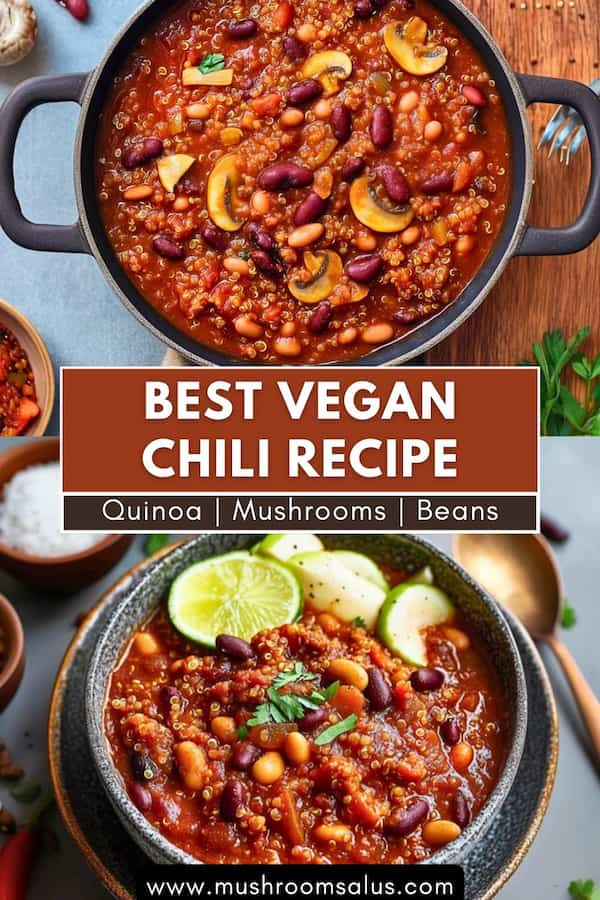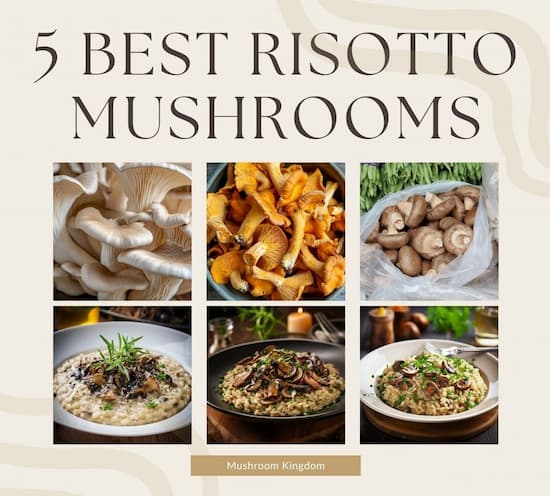A bowl of hearty vegan chili makes for the ultimate comfort food that is not only delicious but also healthy and easy to make.
Whether you’re a vegan, vegetarian, or just looking for a meat-free meal, this chili is perfect for you.
Best of all, it’s customizable, so you can adjust the ingredients based on what you have on hand.
Pin it for later!

Ingredients
The ingredient list for this vegan chili is full of pantry staples and fresh vegetables, making it a convenient recipe to pull together even on short notice.
- 1 medium onion, chopped
- 4 cloves garlic, finely minced
- 1 green bell pepper, chopped
- 1 medium carrot, grated
- 5–6 medium fresh tomatoes (or 1 can, 20 oz diced tomatoes)
- 5 tablespoons tomato paste
- 2 cups water (or vegetable broth)
- 4 cups cooked beans (a mix of kidney, black, pinto, or white beans)
- 2 teaspoons coconut sugar (or substitute with brown sugar or maple syrup)
- 1 teaspoon ground cumin
- 1 teaspoon onion powder
- 1 teaspoon garlic powder
- ¾ teaspoon salt (adjust if using vegetable broth)
- ½ teaspoon black pepper
- ¼ teaspoon smoked paprika
- ¼ teaspoon cayenne pepper
- 1–2 red chili peppers (depending on heat preference)
- 2 teaspoons oil (for frying)
- 1–2 cups mushrooms (optional; chopped or sliced)
- ½ cup quinoa (optional; rinsed)
- 1 cup extra water or broth (if adding quinoa)
Instructions
1. Sauté the Aromatics
Start by heating 2 teaspoons of oil in a large pot over medium heat. Once the oil is warm, add the chopped onion and minced garlic.
Stir frequently for about 3–4 minutes until the onions turn translucent and the garlic releases its rich aroma. This is the base of your chili, and sautéing the onions and garlic first helps develop a deep flavor profile.
2. Add Vegetables for Flavor and Texture
Once your onions and garlic are ready, toss in the chopped green bell pepper and grated carrot. These vegetables not only contribute flavor but also enhance the texture of the chili.
Cook the veggies for about 5–6 minutes, stirring occasionally, until they begin to soften. The carrot adds a subtle sweetness to balance out the savory and spicy elements of the chili.
If you’re adding mushrooms, now is the time! Toss in the chopped or sliced mushrooms along with the green bell pepper and grated carrot. The mushrooms will cook down and release their moisture, adding a meaty texture to the chili.
Continue cooking for 5–6 minutes, stirring occasionally, until the vegetables are soft and the mushrooms have browned slightly.
3. Build the Tomato Base
Add the diced fresh tomatoes or canned tomatoes, along with the tomato paste. Stir the mixture well to coat the vegetables in the rich tomato paste, which deepens the umami flavors of the chili.
If you’re using fresh tomatoes, allow them to cook down for about 5 minutes until they break down and soften. The tomatoes provide the base for the chili’s sauce, adding acidity and sweetness that complement the spices.
4. Season with Spices and Add Beans
Now comes the fun part — adding the spices! Stir in the cumin, onion powder, garlic powder, salt, black pepper, smoked paprika, and cayenne pepper. These spices add warmth, depth, and a hint of smokiness to the chili.
Adjust the amount of cayenne and chili peppers according to your heat preference. If you like your chili mild, use only one chili pepper, but if you prefer a spicy kick, add a second pepper.
After the spices are well incorporated, add the 4 cups of cooked beans. You can use any combination of beans you like, but black beans, kidney beans, and pinto beans work especially well. Beans are the protein powerhouse of this dish, making it a filling and nutritious meal.
5. Add Quinoa
If you’re using quinoa, now is the time to add it. Rinse the quinoa thoroughly before adding it to the pot. Stir in the quinoa along with an additional cup of water or vegetable broth. Quinoa absorbs liquid as it cooks, so the extra broth ensures your chili maintains its thick, hearty consistency. Quinoa will cook as the chili simmers, adding a nutty flavor and extra protein.
6. Pour in the Liquid and Simmer
Pour in 2 cups of water or vegetable broth. The broth will enhance the flavor, but water works just as well if you’re keeping it simple.
Stir everything together and bring the mixture to a boil over medium-high heat. Once it starts to boil, reduce the heat to low and cover the pot. Let the chili simmer for 25–30 minutes, stirring occasionally to prevent sticking.
Simmering allows the flavors to meld together and intensify. The beans will soak up the spices, and the chili will gradually thicken. If you prefer a thicker consistency, simmer it uncovered for the last 10 minutes.
7. Adjust the Seasonings
After the chili has simmered, taste and adjust the seasonings. If you find the chili too acidic from the tomatoes, you can add 2 teaspoons of coconut sugar or another sweetener like brown sugar or maple syrup. This will balance the flavors and add a subtle sweetness. Also, add more salt, pepper, or cayenne as needed.
8. Serve with Toppings
Once your chili has thickened to your liking, remove it from the heat and let it cool slightly before serving. Chili is all about the toppings! You can garnish it with fresh cilantro, sliced avocado, a squeeze of lime juice, or even some crunchy tortilla chips. For an extra kick, add sliced jalapeños or a dollop of vegan sour cream.
Tips for the Best Vegan Chili:
- Vary the Beans: You can experiment with different types of beans, such as cannellini beans or chickpeas, for a unique twist.
- Add More Veggies: Feel free to bulk up your chili with additional vegetables like zucchini, corn, or sweet potatoes. These will add more nutrients and flavor.
- Make It Creamy: For a creamier chili, stir in some coconut milk or a spoonful of peanut butter. This will give it a rich, velvety texture.
- Spice Control: If you’re serving this chili to kids or those sensitive to spice, you can omit the cayenne pepper and chili peppers, then allow people to add hot sauce to their own bowls.
Nutritional Benefits of Vegan Chili:
This vegan chili is packed with health benefits:
- Rich in Fiber: Beans and vegetables are excellent sources of dietary fiber, which aids in digestion and keeps you feeling full longer.
- High in Protein: The beans provide plant-based protein, making this chili an ideal option for vegans and vegetarians looking for a protein boost.
- Loaded with Antioxidants: The tomatoes, peppers, and carrots are full of vitamins and antioxidants that support overall health and immunity.
- Low in Fat: With minimal oil and no animal products, this chili is naturally low in fat, making it heart-healthy and suitable for those watching their fat intake.
Serving Suggestions:
This vegan chili is incredibly versatile and pairs well with a variety of sides. You can serve it with cornbread, over a bed of rice, or with tortilla chips for dipping. For a lighter meal, try serving the chili over a baked sweet potato or as a topping for a salad.
It also makes a fantastic filling for tacos, burritos, or even stuffed bell peppers. If you’re meal prepping, this chili is perfect because it stores well in the fridge for up to five days and can be frozen for up to three months.
Pin it for later!

Conclusion:
This hearty vegan chili is a delicious, comforting dish that everyone will enjoy, whether they’re following a plant-based diet or not. It’s easy to make, full of flavor, and packed with nutritious ingredients.
Plus, it’s perfect for meal prepping and can be enjoyed in a variety of ways. Serve it up with your favorite toppings, and you have a warm, satisfying meal that’s perfect for any occasion.


